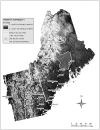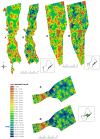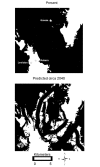Landscape connectivity for bobcat (Lynx rufus) and lynx (Lynx canadensis) in the Northeastern United States
- PMID: 29590192
- PMCID: PMC5874025
- DOI: 10.1371/journal.pone.0194243
Landscape connectivity for bobcat (Lynx rufus) and lynx (Lynx canadensis) in the Northeastern United States
Abstract
Landscape connectivity is integral to the persistence of metapopulations of wide ranging carnivores and other terrestrial species. The objectives of this research were to investigate the landscape characteristics essential to use of areas by lynx and bobcats in northern New England, map a habitat availability model for each species, and explore connectivity across areas of the region likely to experience future development pressure. A Mahalanobis distance analysis was conducted on location data collected between 2005 and 2010 from 16 bobcats in western Vermont and 31 lynx in northern Maine to determine which variables were most consistent across all locations for each species using three scales based on average 1) local (15 minute) movement, 2) linear distance between daily locations, and 3) female home range size. The bobcat model providing the widest separation between used locations and random study area locations suggests that they cue into landscape features such as edge, availability of cover, and development density at different scales. The lynx model with the widest separation between random and used locations contained five variables including natural habitat, cover, and elevation-all at different scales. Shrub scrub habitat-where lynx's preferred prey is most abundant-was represented at the daily distance moved scale. Cross validation indicated that outliers had little effect on models for either species. A habitat suitability value was calculated for each 30 m2 pixel across Vermont, New Hampshire, and Maine for each species and used to map connectivity between conserved lands within selected areas across the region. Projections of future landscape change illustrated potential impacts of anthropogenic development on areas lynx and bobcat may use, and indicated where connectivity for bobcats and lynx may be lost. These projections provided a guide for conservation of landscape permeability for lynx, bobcat, and species relying on similar habitats in the region.
Conflict of interest statement
Figures





Similar articles
-
Urbanization reduces genetic connectivity in bobcats (Lynx rufus) at both intra- and interpopulation spatial scales.Mol Ecol. 2019 Dec;28(23):5068-5085. doi: 10.1111/mec.15274. Epub 2019 Nov 12. Mol Ecol. 2019. PMID: 31613411
-
Habitat connectivity and resource selection in an expanding bobcat (Lynx rufus) population.PeerJ. 2021 Nov 11;9:e12460. doi: 10.7717/peerj.12460. eCollection 2021. PeerJ. 2021. PMID: 34824917 Free PMC article.
-
Habitat selection in a recovering bobcat (Lynx rufus) population.PLoS One. 2022 Aug 1;17(8):e0269258. doi: 10.1371/journal.pone.0269258. eCollection 2022. PLoS One. 2022. PMID: 35914005 Free PMC article.
-
Bobcats (Lynx rufus) as a Model Organism to Investigate the Effects of Roads on Wide-Ranging Carnivores.Environ Manage. 2015 Jun;55(6):1366-76. doi: 10.1007/s00267-015-0468-2. Epub 2015 Apr 2. Environ Manage. 2015. PMID: 25832342
-
Gene flow and pathogen transmission among bobcats (Lynx rufus) in a fragmented urban landscape.Mol Ecol. 2012 Apr;21(7):1617-31. doi: 10.1111/j.1365-294X.2012.05493.x. Epub 2012 Feb 15. Mol Ecol. 2012. PMID: 22335296
Cited by
-
Navigating fragmented landscapes: Canada lynx brave poor quality habitats while traveling.Ecol Evol. 2018 Oct 26;8(22):11293-11308. doi: 10.1002/ece3.4605. eCollection 2018 Nov. Ecol Evol. 2018. PMID: 30519444 Free PMC article.
-
Human land-use effects on mammalian mesopredator occupancy of a northeastern Connecticut landscape.Ecol Evol. 2022 Jul 3;12(7):e9015. doi: 10.1002/ece3.9015. eCollection 2022 Jul. Ecol Evol. 2022. PMID: 35795357 Free PMC article.
References
-
- Vashon J, McLellan S, Crowley S, Meehan A, Laustsen K. Canada lynx assessment. 2012. Maine Department of Inland Fisheries and Wildlife. 107 p. http://www.maine.gov/ifw/docs/species_planning/mammals/canadalynx/Lynx%2...
-
- New Hampshire Fish and Game. Canada lynx documented in northern New Hampshire. 2011. http://www.wildlife.state.nh.us/Newsroom/News_2011/news_2011_Q4/lynx_doc.... Accessed 23 December 2011.
-
- Linforth J, Cliche R. Canada Lynx Coming Back to Vermont. 2013. http://www.fws.gov/endangered/map/ESA_success_stories/VT/VT_story2/. Accessed 14 Feb 2014.
-
- Woolmer G, Trombulak SC, Ray JC, Doran PJ, Anderson MG, Baldwin RF, et al. Rescaling the human footprint: A tool for conservation planning at an ecoregional scale. Landsc and Urban Plan 2008;87: 42–53.
-
- Foster D, Donahue B, Kittredge D, Lambert F, Hunter M, Hall BR, et al. Wildlands and Woodlands—A Vision for the New England Landscape. Harvard Forest, Harvard University; Petersham, MA: 2010. 36 p.
Publication types
MeSH terms
LinkOut - more resources
Full Text Sources
Other Literature Sources

